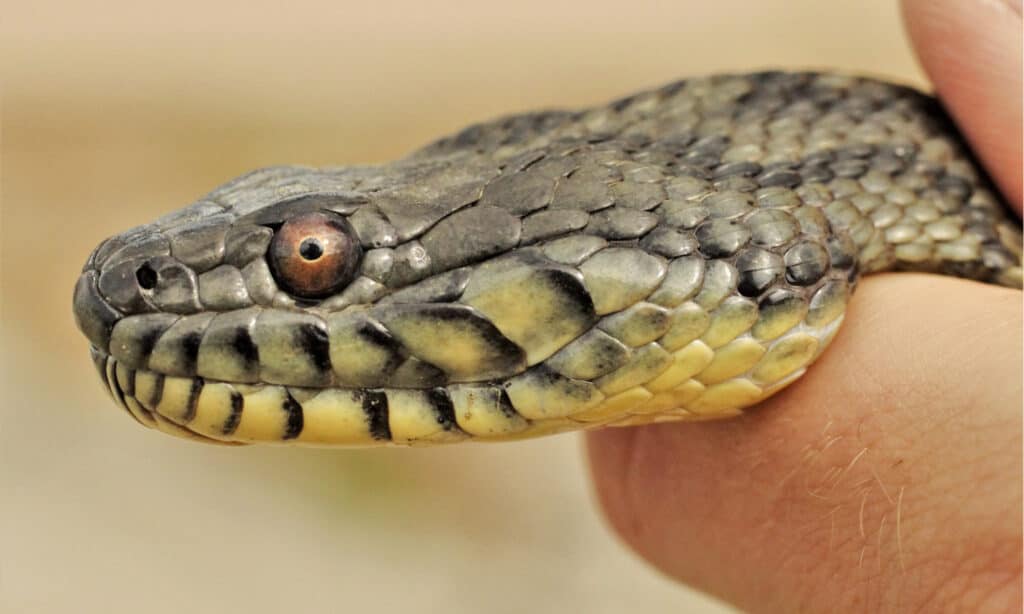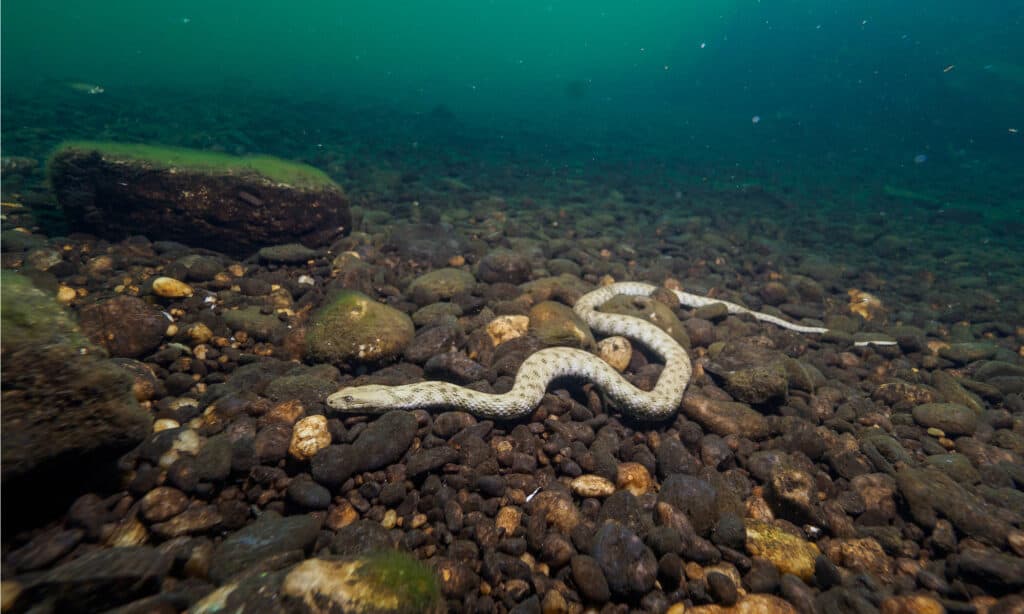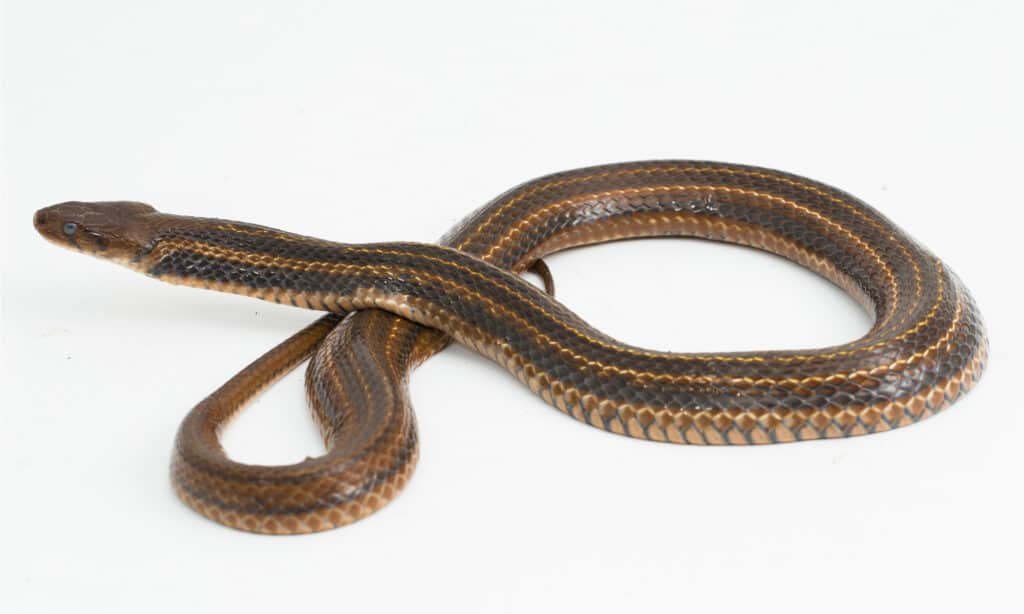Discover 5 Snakes that Eat Fish: Pescatarian Snakes?
#mobileSnakeQuizControls { overflow: hidden; text-overflow: ellipsis; white-space: nowrap; }
@media (min-width: 481px) {
.mobile-top-content {
display: none;
}
}
#mobileTopContentCTACarouselControls { overflow: hidden; text-overflow: ellipsis; white-space: nowrap; }
.mobile-top-content .more { color: #fff; }
.mobile-top-content a { color: #fff; text-decoration: underline; }
.mobile-top-content a:hover { color: #fff; text-decoration: underline; }
@media (max-width: 480px) {
.mobile-top-content {
background-color: #06a10b;
color: #fff;
text-align: center;
/*height: 60px;
padding-top:5px;*/
font-size:80%;
/* display: block; */
margin: 0px -30px;
}
}
There aren’t true pescatarian snakes anywhere, but there are more than five snakes that eat fish as their primary food source on this planet.
Most snakes will eat fish intermittently if a good opportunity presents itself, but there aren’t many snakes that enjoy eating fish. That’s because most snakes aren’t equipped to digest sharp fish bones properly, and they aren’t adept enough at fishing for it to be a meaningful food source.
Your interest in snakes that eat fish might be born from a desire to feed your pet snake the best diet you can, but it’s important to remember that if you’re going to feed your pet snake fish, it cannot be goldfish. They contain something that inhibits thiamine in the snake’s body which causes disorders and death.
button.pulse {
transform: scale(1); animation: pulse 2s infinite;
box-shadow: 0 0 0 0 rgba(11, 247, 25, 1);
}
@keyframes pulse {
0% { transform: scale(0.90); box-shadow: 0 0 0 0 rgba(11, 247, 25, 0.5); }
60% { transform: scale(1); box-shadow: 0 0 0 15px rgba(11, 247, 25, 0); }
100% { transform: scale(0.90); box-shadow: 0 0 0 0 rgba(11, 247, 25, 0); }
}
What are five of the snakes that eat fish? The nitty-gritty on our picks begins now.
1. Garter Snake

iStock.com/Wildnerdpix
Garter snakes live in North America and are also known as garden snakes. They’re referred to as “common” because they’re the most common snakes in the United States. They’re usually found in gardens, although they like being near small bodies of water.
The garter snake really isn’t venomous to humans as the venom has no real effect. Though, it delivers a neurotoxin when it bites, which is effective against prey.
It was observed at a hatchery that garter snakes, on extremely hot days, could enter the cold-water channels to forage for fish because their body temperatures were so high from being outside. The fish in their diet are smaller, such as guppies and minnows, when they’re in captivity. Keeping a garter snake as a pet is common, and there are quite a few different morphs to pick from if you’re looking to own one.
2. Cottonmouth

Marcum Havens/Shutterstock.com
The water moccasin is another name for this snake because it’s so good in the water. It prefers fish, though it can take down most things it can strike because it’s highly venomous. The southeastern United States is the cottonmouth’s home.
Some cottonmouths have a diet that is mainly fish that are regurgitated or dropped from nesting birds in the summer months. These specific cottonmouths will even eat dirt if it smells like fish that the birds would drop.
The idea that snakes are omnivores sometimes stems from a misinterpretation of things like soil that snakes will rarely eat. The cottonmouth’s excrement may contain leaves and other litter because it is seeking a carnivorous protein source. It is not inherently omnivorous.
The cottonmouth is named so because of its white mouth, which it shows when threatened. The mouth is as white as cotton, and that visual impression earned it the name cottonmouth. Cottonmouths again are extremely venomous, so keep your distance if you encounter one.
3. Water Snake

Seth LaGrange/Shutterstock.com
The name water snake refers to a handful of different types of snakes, although they all have inherent similarities. They’re found in and around the United States and are semi-aquatic animals.
Water snakes actively forage for food, including looking for fish where it’s shallow. They like to hang out in branches above water sources. Northern water snakes show that contamination in the environment affects a larger ecosystem. A contaminated watershed was examined, and water snakes showed a high concentration of toxic waste in their tissue. This toxin contamination carried over to their eggs as well.
A contaminate study was also done on banded water snakes, and it showed that harmful elements in fish that were consumed created elevated levels of those contaminants in the snake. Another study showed that mother northern water snakes that transfer quantities of mercury to their babies do not damage the number of offspring and the infant survival rate.
Mistaken for water moccasins, northern water snakes come off scarier than they really are. Fish hatcheries commonly see water snakes that like to dine on the fingerling and fry of trout.
4. Dice Snake

benny337/Shutterstock.com
Dice snakes are in Eurasia and Egypt, and they’re centered in Romania.
Searching in crevices and other holes in the water is a dice snake’s specialty. Dice snakes are active foragers that go in search of their next meal. They are semi-aquatic and love to spend time in water.
When a habitat that the dice snake lives in loses a prey source, another one can come in and take its place. A native fish in a lake was replaced by an invasive species, and the dice snake had no problem consuming them in place of the original fish.
Dice snakes in Croatia have been shown to eat mostly fish, whereas sympatric grass snakes eat amphibians and other animals. While grass snakes don’t prefer fish and dice snakes do, they both like to take part in other types of food. No one wants to eat the same food every meal, including snakes.
When the dice snake and the grass snake are in their overlapping territories, the grass snakes eat more fish so that the dice snake and the grass snake aren’t competing for all of the terrestrial food sources.
5. Checkered Keelback

dwi putra stock/Shutterstock.com
When checkered keelbacks eat is dependent on the seasons like most snakes. Over a quarter of their diet is fish. Snakes eat most of their food in the summer and don’t eat in the winter because their metabolism slows down. Checkered keelbacks are no different.
They also love frogs and sometimes dine on birds and rodents. They’ll even climb trees to reach birds, when necessary, even though the water is their ultimate jam. In urban areas, these snakes get creative and eat whatever they are presented with, like boiled chicken and rice.
As nonvenomous snakes that enjoy freshwater, they are common in human-inhabited areas in India, parts of the Middle East, China, and some of Southeast Asia.
Discover the “Monster” Snake 5X Bigger than an Anaconda
Every day A-Z Animals sends out some of the most incredible facts in the world from our free newsletter. Want to discover the 10 most beautiful snakes in the world, a “snake island” where you’re never more than 3 feet from danger, or a “monster” snake 5X larger than an anaconda? Then sign up right now and you’ll start receiving our daily newsletter absolutely free.
More from A-Z Animals
.more-snake-card-image { max-height:140px !important; }
#mobileSnakeQuizControls { overflow: hidden; text-overflow: ellipsis; white-space: nowrap; }
@media (min-width: 481px) {
.mobile-top-content {
display: none;
}
}
#mobileTopContentCTACarouselControls { overflow: hidden; text-overflow: ellipsis; white-space: nowrap; }
.mobile-top-content .more { color: #fff; }
.mobile-top-content a { color: #fff; text-decoration: underline; }
.mobile-top-content a:hover { color: #fff; text-decoration: underline; }
@media (max-width: 480px) {
.mobile-top-content {
background-color: #06a10b;
color: #fff;
text-align: center;
/*height: 60px;
padding-top:5px;*/
font-size:80%;
/* display: block; */
margin: 0px -30px;
}
}
There aren’t true pescatarian snakes anywhere, but there are more than five snakes that eat fish as their primary food source on this planet.
Most snakes will eat fish intermittently if a good opportunity presents itself, but there aren’t many snakes that enjoy eating fish. That’s because most snakes aren’t equipped to digest sharp fish bones properly, and they aren’t adept enough at fishing for it to be a meaningful food source.
Your interest in snakes that eat fish might be born from a desire to feed your pet snake the best diet you can, but it’s important to remember that if you’re going to feed your pet snake fish, it cannot be goldfish. They contain something that inhibits thiamine in the snake’s body which causes disorders and death.
button.pulse {
transform: scale(1); animation: pulse 2s infinite;
box-shadow: 0 0 0 0 rgba(11, 247, 25, 1);
}
@keyframes pulse {
0% { transform: scale(0.90); box-shadow: 0 0 0 0 rgba(11, 247, 25, 0.5); }
60% { transform: scale(1); box-shadow: 0 0 0 15px rgba(11, 247, 25, 0); }
100% { transform: scale(0.90); box-shadow: 0 0 0 0 rgba(11, 247, 25, 0); }
}
What are five of the snakes that eat fish? The nitty-gritty on our picks begins now.
1. Garter Snake

iStock.com/Wildnerdpix
Garter snakes live in North America and are also known as garden snakes. They’re referred to as “common” because they’re the most common snakes in the United States. They’re usually found in gardens, although they like being near small bodies of water.
The garter snake really isn’t venomous to humans as the venom has no real effect. Though, it delivers a neurotoxin when it bites, which is effective against prey.
It was observed at a hatchery that garter snakes, on extremely hot days, could enter the cold-water channels to forage for fish because their body temperatures were so high from being outside. The fish in their diet are smaller, such as guppies and minnows, when they’re in captivity. Keeping a garter snake as a pet is common, and there are quite a few different morphs to pick from if you’re looking to own one.
2. Cottonmouth

Marcum Havens/Shutterstock.com
The water moccasin is another name for this snake because it’s so good in the water. It prefers fish, though it can take down most things it can strike because it’s highly venomous. The southeastern United States is the cottonmouth’s home.
Some cottonmouths have a diet that is mainly fish that are regurgitated or dropped from nesting birds in the summer months. These specific cottonmouths will even eat dirt if it smells like fish that the birds would drop.
The idea that snakes are omnivores sometimes stems from a misinterpretation of things like soil that snakes will rarely eat. The cottonmouth’s excrement may contain leaves and other litter because it is seeking a carnivorous protein source. It is not inherently omnivorous.
The cottonmouth is named so because of its white mouth, which it shows when threatened. The mouth is as white as cotton, and that visual impression earned it the name cottonmouth. Cottonmouths again are extremely venomous, so keep your distance if you encounter one.
3. Water Snake

Seth LaGrange/Shutterstock.com
The name water snake refers to a handful of different types of snakes, although they all have inherent similarities. They’re found in and around the United States and are semi-aquatic animals.
Water snakes actively forage for food, including looking for fish where it’s shallow. They like to hang out in branches above water sources. Northern water snakes show that contamination in the environment affects a larger ecosystem. A contaminated watershed was examined, and water snakes showed a high concentration of toxic waste in their tissue. This toxin contamination carried over to their eggs as well.
A contaminate study was also done on banded water snakes, and it showed that harmful elements in fish that were consumed created elevated levels of those contaminants in the snake. Another study showed that mother northern water snakes that transfer quantities of mercury to their babies do not damage the number of offspring and the infant survival rate.
Mistaken for water moccasins, northern water snakes come off scarier than they really are. Fish hatcheries commonly see water snakes that like to dine on the fingerling and fry of trout.
4. Dice Snake

benny337/Shutterstock.com
Dice snakes are in Eurasia and Egypt, and they’re centered in Romania.
Searching in crevices and other holes in the water is a dice snake’s specialty. Dice snakes are active foragers that go in search of their next meal. They are semi-aquatic and love to spend time in water.
When a habitat that the dice snake lives in loses a prey source, another one can come in and take its place. A native fish in a lake was replaced by an invasive species, and the dice snake had no problem consuming them in place of the original fish.
Dice snakes in Croatia have been shown to eat mostly fish, whereas sympatric grass snakes eat amphibians and other animals. While grass snakes don’t prefer fish and dice snakes do, they both like to take part in other types of food. No one wants to eat the same food every meal, including snakes.
When the dice snake and the grass snake are in their overlapping territories, the grass snakes eat more fish so that the dice snake and the grass snake aren’t competing for all of the terrestrial food sources.
5. Checkered Keelback

dwi putra stock/Shutterstock.com
When checkered keelbacks eat is dependent on the seasons like most snakes. Over a quarter of their diet is fish. Snakes eat most of their food in the summer and don’t eat in the winter because their metabolism slows down. Checkered keelbacks are no different.
They also love frogs and sometimes dine on birds and rodents. They’ll even climb trees to reach birds, when necessary, even though the water is their ultimate jam. In urban areas, these snakes get creative and eat whatever they are presented with, like boiled chicken and rice.
As nonvenomous snakes that enjoy freshwater, they are common in human-inhabited areas in India, parts of the Middle East, China, and some of Southeast Asia.
Discover the “Monster” Snake 5X Bigger than an Anaconda
Every day A-Z Animals sends out some of the most incredible facts in the world from our free newsletter. Want to discover the 10 most beautiful snakes in the world, a “snake island” where you’re never more than 3 feet from danger, or a “monster” snake 5X larger than an anaconda? Then sign up right now and you’ll start receiving our daily newsletter absolutely free.







